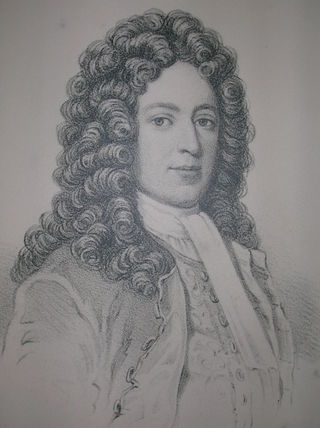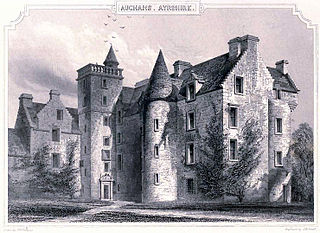This article includes a list of general references, but it lacks sufficient corresponding inline citations .(January 2011) |
Sir John Cochrane of Ochiltree (d.c. 1707) was a Scottish nobleman, soldier, and conspirator.
This article includes a list of general references, but it lacks sufficient corresponding inline citations .(January 2011) |
Sir John Cochrane of Ochiltree (d.c. 1707) was a Scottish nobleman, soldier, and conspirator.
Cochrane was the second son of William Cochrane, 1st Earl of Dundonald, by Eupheme, daughter of Sir William Scott of Ardross, Director of Chancery at the Court of Session.
He was one of the main promoters of the Carolina Company which established a Scottish colony at Port Royal, South Carolina. [1] : 30–31
Cochrane was implicated in the Rye House plot (1683) and the Monmouth Rebellion, but escaped to Rotterdam, [1] : 33 where he remained till the death of Charles II. On the accession of James II he was attainted while still abroad. He took part in the Earl of Argyll's insurrection in 1685, on the suppression of which he was harboured for a time by his kinsman, Gavin Cochrane of Renfrew. Betrayed by Gavin Cochrane's wife, whose brother had fallen in a skirmish on the royalist side, he was carried to Edinburgh, led through the streets by the hangman, and lodged in the Tolbooth. Charged with high treason he is said by Lord Fountainhall to have turned approver and saved his head. Burnet states that the Earl of Dundonald bought his son's pardon by a payment of £5,000 to 'the priests,' and denies that Cochrane disclosed anything of importance.
On the promulgation of the declaration of indulgence he was employed (1687) to urge its acceptance upon the Presbyterians. His estates were restored to him in 1689.
He subsequently held the position of farmer of the poll tax, and in 1695, failing to give satisfactory account of moneys received by him in that capacity, was committed to prison.
By his wife Margaret, daughter of Sir William Strickland of Boynton, Yorkshire, one of Cromwell's lords of parliament, he had two sons.
The date of his death is uncertain.

Thomas Cochrane, 10th Earl of DundonaldGCB, styled Lord Cochrane between 1778 and 1831, was a Scottish naval officer, peer, mercenary and politician. Serving during the French Revolutionary and Napoleonic Wars in the Royal Navy, his naval successes led Napoleon to nickname him le Loup des Mers. He was successful in virtually all of his naval actions.

William Douglas-Hamilton, Duke of Hamilton, KG, PC, also known as Lord William Douglas and the Earl of Selkirk, was a Scottish nobleman and politician. He was the eldest son of the 1st Marquess of Douglas by his second wife, Lady Mary Gordon, a daughter of the 1st Marquess of Huntly.

Earl of Dundonald is a title in the Peerage of Scotland. It was created in 1669 for the Scottish soldier and politician William Cochrane, 1st Lord Cochrane of Dundonald, along with the subsidiary title of Lord Cochrane of Paisley and Ochiltree, with remainder to his heirs male, failing which to his heirs female without division who should bear or assume the name of Cochrane, and in failure thereof to his heirs general. In 1647, he had already been created Lord Cochrane of Dundonald in the Peerage of Scotland, with remainder to the heirs male of his body.

Archibald Cochrane, 9th Earl of Dundonald FRSE was a Scottish nobleman and inventor.

Alexander Seton Montgomerie, 9th Earl of Eglinton was a Scottish peer, lord of the Eglinton Estate.
Alexander Stewart, 6th Earl of Galloway was a Scottish aristocrat.

John Hay, 2nd Marquess of Tweeddale PC was a Scottish nobleman.
William Cochrane of Kilmaronock, Dunbarton was a Scottish politician who sat in the Parliament of Scotland between 1689 and 1707 and as a Tory in the House of Commons from 1708 to 1713.

John Hay, 4th Marquess of Tweeddale, was a Scottish nobleman.

Clan Cochrane is a Scottish clan of the Scottish Lowlands.

James Hope-Johnstone, 3rd Earl of Hopetoun FRSE was a Scottish peer, politician and military officer.
Thomas Cochrane, 8th Earl of Dundonald was a Scottish nobleman, army officer and politician. He was Member of Parliament for Renfrewshire, 1722–1727. He served as Commissioner of the Excise for Scotland from 1730 until 1764. He acceded to the title of Earl of Dundonald in 1758 on the death of his cousin, William Cochrane, 7th Earl of Dundonald.

Auchans Castle, House, House of Auchans or Old Auchans, is a mock military mansion, Category A listed, T-plan building of a late 16th-century date converted to the L-plan during the early-to-mid-17th century; its ruins stand about 1 km W of Dundonald, South Ayrshire, Scotland. Parish of Dundonald. It was held at various times by the Wallace, Cochrane and Montgomerie families.
George Ross, 11th Lord Ross of Halkhead, was a Scottish nobleman and soldier.
William Cochrane, 1st Earl of Dundonald supported the Royalist cause during the Wars of the Three Kingdoms.
Andrew James Cochrane-Johnstone was a Scottish soldier, politician, swindler and adventurer who was found guilty of participation in the Great Stock Exchange Fraud of 1814. He was born in Edinburgh, Scotland.
Grizel Cochrane is a figure from 17th century Scottish lore. Cochrane's father, John Cochrane of Ochiltree, had been captured following the Monmouth Rebellion against the rule of James VII, in 1685, and was therefore scheduled to be condemned to death. According to the legend, in order to prevent the execution from being carried out, Grizel disguised herself as a man and robbed the postman who carried the death warrant, on a lonely part of Tweedmouth Moor. When initial efforts to seek a pardon were unsuccessful, Grizel robbed the postman a second time fourteen days later, to again stave off the execution. The second robbery provided enough time for the pardon to be secured.
She threatened the man with instant death, and so terrified him that she obtained possession of the papers he carried. As she had foreseen, this delay in the execution gave time for friends in London to raise a ransom, so the heroic girl saved her father and made her name famous in Scottish legend.
Mr. [Catesby]’s father, a merchant in Edinburgh, had married a daughter of Sir John Stuart, whose mother was a grand-daughter of Miss Grizel Cochrane, daughter of Sir John Cochrane, the son of the first Earl of Dundonald. We have mentioned the course of this genealogy for the sake of noticing an unexampled instance of female heroism and filial affection performed by Grizel Cochrane in behalf of her father, who was one of the principal performers in Argyle's rebellion against the tyranny and bigotry of James the Second. The doom that enveloped the house of Campbell affected the safety of Sir John Cochrane; he was taken prisoner after a deadly struggle, tried, and condemned to die upon the scaffold. The royal warrant for his execution was hourly expected— the prisoner's father, the Earl of Dundonald, hastened to London, to exert his influence in behalf of his unfortunate son—but he had scarcely left the good city of Berwick ere the authorities were apprised that the next mail would bring the death warrant of Sir John. But that mail never reached its destination—the rider was attacked upon the dreary moor of Tweedmouth, by a stripling in a coarse jerkin and cloak, who grasped the mail bag and disappeared in the shades of the might. The prisoner was not led to execution. Fourteen days elapsed, and the efforts of his father were unsuccessful—a letter was received from the anxious parent with the painful intelligence that another warrant was to be despatched by the ensuing mail. Preparations were again made for the execution, when news reached the city that the mail carrier had again been robbed—not only of the mail, but of his horse, on which the assailer mounted with the leathern bag, and fled rapidly away. Fourteen days must again elapse ere the warrant could be renewed—but just before the expiration of the time, the old Earl of Dundonald rushed into the arms of his son, and proved to be the bearer of his pardon, wrung from the king, by the interest of Father Petre, his confessor, who had stipulated to receive the sum of five thousand pounds as the price of his intercession. The mail robber was the prisoner's daughter, Grizel Cochrane, who, in disguise, had twice perilled her life in attempting the arduous achievement, but received her reward in the rescue of her beloved sire.
John Cochrane, 4th Earl of Dundonald, was a Scottish aristocrat and politician.
Thomas Cochrane, 6th Earl of Dundonald was a Scottish aristocrat.
Lord Basil Hamilton was a Scottish aristocrat who drowned trying to save his servant.